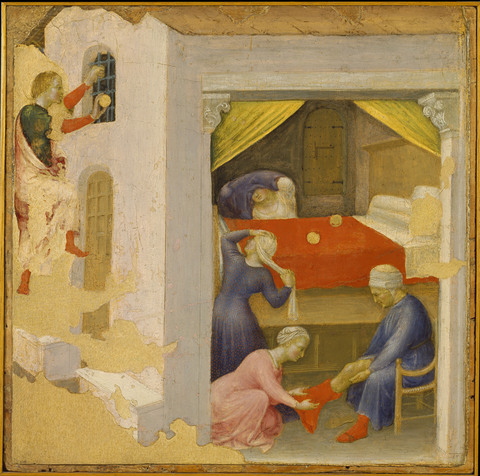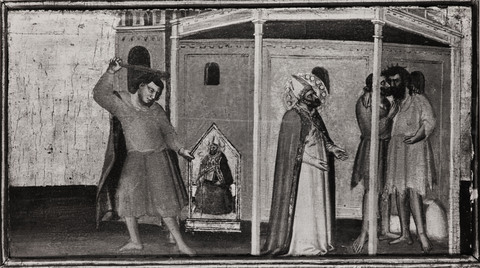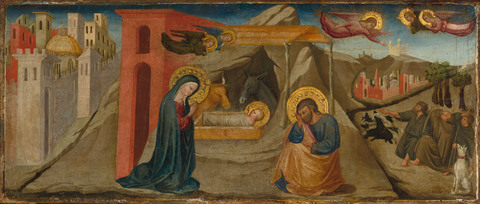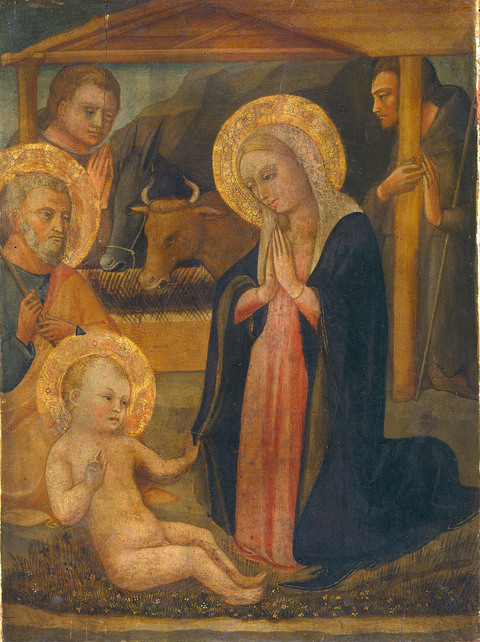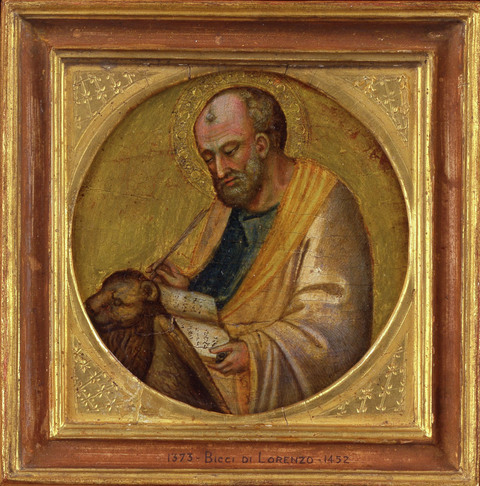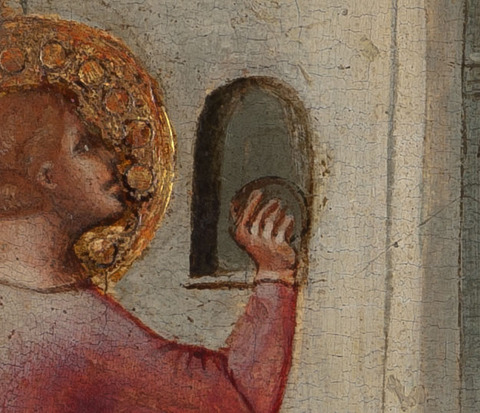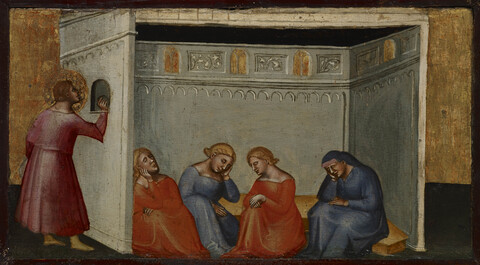Marks, Inscriptions, and Distinguishing Features
None
Entry
Since entering the Clowes Collection, Scene from the Legend of St. Nicholas has undergone two attribution changes. In 1929, the art historian William Suida confirmed an earlier attribution to the Florentine artist Mariotto di Nardo (1394–1424). About twenty years later, Suida examined the painting again and changed the attribution to Simone di Filippo da Bologna (1335–1399), arguing that the style was more in line with that of an artist in Bologna than Tuscany. In his unpublished “Clowes Collection Catalogue” from 1968, the art historian Mark Roskill stated that neither attribution was convincing. Through the early 1970s, however, the painting was still assigned to Mariotto in museum records. By the twenty-first century, the attribution returned to that of a Tuscan artist, namely, Bicci di Lorenzo.
Bicci di Lorenzo (1373–1452) was the son of Lorenzo di Bicci (1350–1427), and both artists worked throughout Tuscany. In his Lives of the Most Eminent Painters, Sculptors, and Architects, Giorgio Vasari credits Lorenzo and his son Bicci as the last masters to follow in the manner established by Giotto. The panel could have been created by either painter, as they were working in their Florentine workshop together at the turn of the fifteenth century. The family workshop continued well into the mid-fifteenth century as Neri di Bicci—Bicci’s son and Lorenzo’s grandson—took over the business. Vasari describes the workshop as successful, with commissions from the Medici family, as well as works completed for the cathedral of Florence.
This episode from the life of St. Nicholas comes from Jacobus de Voragine’s thirteenth-century compilation of saints known as the Golden Legend. In the story, a nobleman of little means was unable to provide his three daughters with dowries, which meant that they could not be married. Instead, his only choice for his children was to sell them into prostitution. Nicholas, a wealthy man, heard of the man’s predicament and decided to secretly help him. One night, Nicholas snuck to the family’s house and dropped in a ball of gold wrapped in a cloth. Upon finding the treasure the next morning, the poor man praised God and arranged to have his oldest daughter married. Nicholas repeated this generous act for the other two daughters. In some versions of the story, the poor man discovered Nicholas on the third occasion, and Nicholas insisted the man keep his actions a secret until after his death. From these events arose the tradition of gifting children with presents in December.
When portraying this scene, many artists condensed the entire story into one composition. Thus, in Gentile da Fabriano’s version from 1425 (fig. 1), and a version by Bicci in 1433–35 that directly references Gentile’s panel (fig. 2), all three pieces of gold are delivered to the family at once. For the earlier Clowes painting, Bicci di Lorenzo shows Nicholas delivering the first of the three balls of gold into the family’s home. To the left, Nicholas—portrayed with a halo in anticipation of his sainthood—drops the gold, unwrapped, so the viewer may discern it, through the window. Inside the house, the three daughters and their father are asleep, though their faces express grief and worry. The composition includes a simple rectangular room, cut away like a doll’s house so that the viewer can see inside. Besides decorative arches, foliage motifs, and small windows, the structure is otherwise unadorned. As is common in fifteenth-century altarpiece panels, the background consists of a simple ground plane and a gold-foil finish in place of sky or scenery.
Figure 1: Gentile da Fabriano (Italian, 1385–1427), Quaratesi Polyptych: Saint Nicholas of Bari Giving Three Balls of Gold to Three Poor Girls, 1425, tempera on panel, 14-9/16 × 14-9/16 in. Pinacoteca, Vatican Museums, Vatican State, Cat, 40248.
Figure 1: Gentile da Fabriano (Italian, 1385–1427), Quaratesi Polyptych: Saint Nicholas of Bari Giving Three Balls of Gold to Three Poor Girls, 1425, tempera on panel, 14-9/16 × 14-9/16 in. Pinacoteca, Vatican Museums, Vatican State, Cat, 40248.
Figure 2: Bicci di Lorenzo (Italian, 1373–1452), Saint Nicholas Providing Dowries, 1433–35, tempera and gold on wood, 12 × 22-1/4 in. The Metropolitan Museum of Art, New York, Gift of Coudert Brothers, 1888, 88.3.89.
Figure 2: Bicci di Lorenzo (Italian, 1373–1452), Saint Nicholas Providing Dowries, 1433–35, tempera and gold on wood, 12 × 22-1/4 in. The Metropolitan Museum of Art, New York, Gift of Coudert Brothers, 1888, 88.3.89.
Stylistically, the composition has an economical use of space, prevalent in early fifteenth-century Florentine painting. Through setting and gestures, Bicci di Lorenzo has efficiently captured this moment in the story. Though the house is furnished only with a wooden seat, it is clear that the family is inside their home while Nicholas, outside, peers through a window. The father and three daughters are unaware of what is about to transpire. They are united by the alternating red and blue of their simple garments; the father’s cap and buttons distinguish him from his daughters. Despite a lack of sky, grass, plants, or other landscape elements, Nicholas is understood to be outside the home. Arm poised, he is about to drop the ball through the window to the unsuspecting family. Rather than embellish with detail or artistic virtuosity, Bicci di Lorenzo sought to convey only what was necessary to inform viewers of Nicholas’s good deeds.
Due to its shape and size, this panel was most likely part of a
predella for a larger altarpiece. While the central panel probably depicted the Virgin and Child, the others of the predella series would have included additional scenes from the life of St. Nicholas. Another panel listed in a 1982 private collection likely belongs to this set. This painting depicts another St. Nicholas episode from Voragine’s
Golden Legend (fig. 3). In it, the artist portrays the story of a Jewish moneylender who entrusted the safety of his property to an artwork of St. Nicholas. After the man is robbed, he beats the image for not doing its job. Nicholas himself appears before the guilty thieves and insists they return the Jewish man’s belongings so he will not continue to suffer the man’s wrath. The thieves promptly do so, and the Jewish man converts to Christianity in gratitude to Nicholas. As in the Clowes panel, the artist used an economic composition with simple architecture and a gilt background. To the left, the moneylender attacks the artwork while on the right Nicholas confronts the thieves. Together, these and the other panels would have been arranged horizontally along the bottom of the main altarpiece. As art styles and tastes changed from the sixteenth to nineteenth centuries, many churches or noble families paid to have more modern altarpieces installed in churches. As a result, many multiscene altarpieces from the premodern period were dismantled and the individual panels sold. While it remains unknown to which altarpiece and church these panels originally belonged, it is nearly certain they once completed part of a larger whole.
Figure 3: Bicci di Lorenzo (Italian, 1373–1452), Scene from the Legend of St. Nicholas: St. Nicholas and the Jewish Moneylender, about 1400–1410, tempera and gold on wood, 7-1/16 × 13-3/8 in. Whereabouts unknown (formerly Alfred E. Stehli, Zurich).
Figure 3: Bicci di Lorenzo (Italian, 1373–1452), Scene from the Legend of St. Nicholas: St. Nicholas and the Jewish Moneylender, about 1400–1410, tempera and gold on wood, 7-1/16 × 13-3/8 in. Whereabouts unknown (formerly Alfred E. Stehli, Zurich).
The Clowes painting is similar to other works by Bicci di Lorenzo and the family workshop. Notably, many of Bicci’s works are predella panels. Given the relatively early date of this work compared to his other known paintings, it was likely completed while he was an apprentice to Lorenzo. During this time, Bicci’s work closely recalls that of Agnolo Gaddi, the son of Taddeo Gaddi who studied directly with Giotto. Later works by Bicci, such as
Saint Nicholas Providing Dowries (Metropolitan Museum of Art), as well as his
Nativity predella panel (Fogg Museum), show an evolution in his style that aligns with the International Gothic popularized by Gentile da Fabriano (fig. 4). In the panel from 1433 to 1435 in New York, Bicci depicts Nicholas delivering all three gold balls at once while the family is getting ready for bed. The composition has also been expanded to include domestic furniture and landscape. This transition from economy of space to a more embellished scene hints at the increasing popularity of the International Gothic style by the mid-fifteenth century. As such, the Clowes panel is indicative of Bicci’s training in his father’s workshop, which followed more closely the compositional principles set forth by Giotto in the fourteenth century. Later in Bicci’s career, his works became more complex, which is evident in his
Adoration of the Christ Child (National Gallery of Art, Washington, D.C.) from 1440 to 1445 (fig. 5). However, throughout his oeuvre, Bicci’s works maintain similar characteristics, such as elongated, outlined fingers, and similar punchwork, such as the halos in the Clowes panel and the IMA painting of
St. Mark, completed by Bicci in 1430 (fig. 6).
Figure 4: Bicci di Lorenzo (Italian, 1373–1452), The Nativity and the Annunciation to the Shepherds, about 1440, tempera on panel, 12-1/16 × 29-1/2 in. Harvard Art Museums/Fogg Museum, Gift of Mr. and Mrs. Bernard Berenson, 1920.19. Photo © President and Fellows of Harvard College.
Figure 4: Bicci di Lorenzo (Italian, 1373–1452), The Nativity and the Annunciation to the Shepherds, about 1440, tempera on panel, 12-1/16 × 29-1/2 in. Harvard Art Museums/Fogg Museum, Gift of Mr. and Mrs. Bernard Berenson, 1920.19. Photo © President and Fellows of Harvard College.
Figure 5: Bicci di Lorenzo (Italian, 1373–1452), The Adoration of the Christ Child, about 1440/1445, tempera on poplar panel, 18-7/8 × 14-1/4 in. National Gallery of Art, Washington, D.C., Timken Collection, 1960.6.25.
Figure 5: Bicci di Lorenzo (Italian, 1373–1452), The Adoration of the Christ Child, about 1440/1445, tempera on poplar panel, 18-7/8 × 14-1/4 in. National Gallery of Art, Washington, D.C., Timken Collection, 1960.6.25.
Figure 6: Bicci di Lorenzo (Italian, 1373–1452), St. Mark, about 1430, tempera and gold on wood, 5-1/4 (diam.) in. (board), 12-1/4 × 12/-1/4 in. (framed). Indianapolis Museum of Art at Newfields, James E. Roberts Fund, 52.61.
Figure 6: Bicci di Lorenzo (Italian, 1373–1452), St. Mark, about 1430, tempera and gold on wood, 5-1/4 (diam.) in. (board), 12-1/4 × 12/-1/4 in. (framed). Indianapolis Museum of Art at Newfields, James E. Roberts Fund, 52.61.
Regarding condition, this panel painting is in adequate shape. While some of the gold foil is damaged and reveals the red
bole underneath, most of the gilding is intact. The damage is most evident on the ball in Nicholas’s hand, which has nearly lost all of its gold and only the
underdrawing remains (fig. 7). Several indentations along the top and bottom of the panel, which have caused minor paint loss, are also present. Infrared imaging indicates some paint
retouching along the bottom of the panel. The rest of the surface paint remains largely intact, including the artist’s use of white highlights on the family’s facial features.
Figure 7: Bicci di Lorenzo (Italian, 1373–1452), Scene from the Legend of St. Nicholas (detail), about 1400–10, tempera and gold on wood, 7 × 13-1/2 in. (panel), 12-3/4 × 18-3/4 in. (framed). Indianapolis Museum of Art at Newfields, The Clowes Collection, 2010.41.
Figure 7: Bicci di Lorenzo (Italian, 1373–1452), Scene from the Legend of St. Nicholas (detail), about 1400–10, tempera and gold on wood, 7 × 13-1/2 in. (panel), 12-3/4 × 18-3/4 in. (framed). Indianapolis Museum of Art at Newfields, The Clowes Collection, 2010.41.
Ideally, the remaining panels of the altarpiece would be discovered and have the opportunity to reunite with this scene. With other pieces for comparison, more could be said about any potential damage or alterations to the panel that are not otherwise obvious. Location of the rest of the work may also indicate what order or church to which this piece belonged, thus providing a piece of its social history and context. Until that time, this remains a well-preserved panel from one of the fifteenth century’s popular workshops.
Author
Andrea Kibler Maxwell
Provenance
Probably part of a predella at the base of a fifteenth-century Italian altarpiece, detached at an unknown date.
Eugen Rieffel-Müller, Frankfurt, by 1925.
(E. and A. Silberman Galleries, New York);
G.H.A. Clowes, Indianapolis, by 1934;
The Clowes Fund, Indianapolis, from 1958–2010, and on long-term loan to the Indianapolis Museum of Art since 1971 (C10057).
Given to the Indianapolis Museum of Art, now the Indianapolis Museum of Art at Newfields, in 2010.
Exhibitions
Staedel Institut, Frankfurt-am-Main, 1925, Austellung von Meisterwerken alter Malerei aus Privatbesitz, no. 67;
John Herron Art Museum, Indianapolis, IN, 1959, Paintings from the Collection of George Henry Alexander Clowes: A Memorial Exhibition, no. 41;
The Art Gallery, University of Notre Dame, Notre Dame, IN, 1962, A Lenten Exhibition, no. 36;
Indiana University Museum of Art, Bloomington, IN, 1962, Italian and Spanish Paintings from the Clowes Collection, no. 4.
References
O. Gotz, G. Swarzenski, and A. Wolters, Ausstellung von Meisterwerken alter Malerei aus Privatbesitz (Frankfurt-am-Main: Staedel Institut, 1925), no. 67 (reproduced), as Mariotto di Nardi;
Paintings from the Collection of George Henry Alexander Clowes: A Memorial Exhibition (Indianapolis: John Herron Art Museum, 1959), no. 4, as Mariotto di Nardi;
Mark Roskill, “Clowes Collection Catalogue” (unpublished typed manuscript, IMA Clowes archive, Newfields, Indianapolis, IN, 1968);
A. Ian Fraser, A Catalogue of the Clowes Collection (Indianapolis: Indianapolis Museum of Art, 1973), 4, attributed to Simone di Filippo da Bologna (Crocifissi).
Notes
